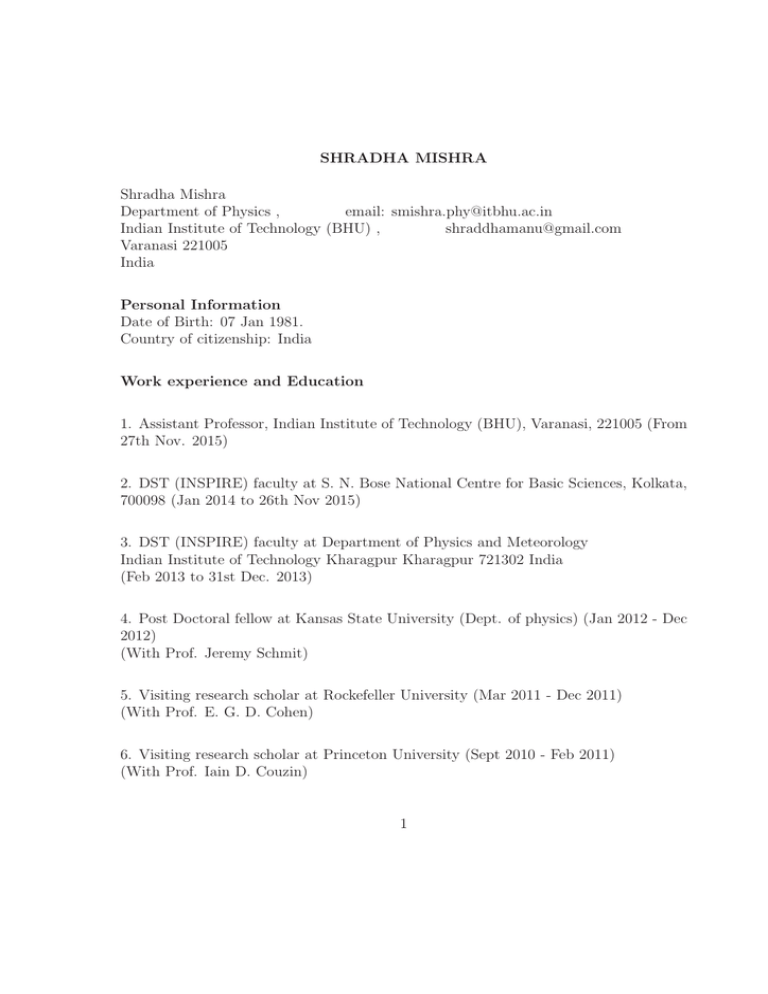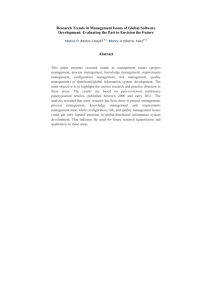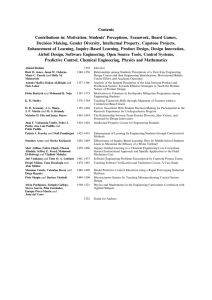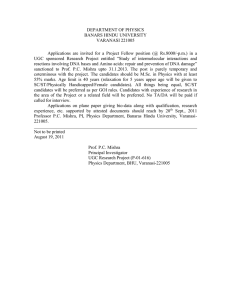SHRADHA MISHRA Shradha Mishra Department of Physics , email
advertisement

SHRADHA MISHRA Shradha Mishra Department of Physics , email: smishra.phy@itbhu.ac.in Indian Institute of Technology (BHU) , shraddhamanu@gmail.com Varanasi 221005 India Personal Information Date of Birth: 07 Jan 1981. Country of citizenship: India Work experience and Education 1. Assistant Professor, Indian Institute of Technology (BHU), Varanasi, 221005 (From 27th Nov. 2015) 2. DST (INSPIRE) faculty at S. N. Bose National Centre for Basic Sciences, Kolkata, 700098 (Jan 2014 to 26th Nov 2015) 3. DST (INSPIRE) faculty at Department of Physics and Meteorology Indian Institute of Technology Kharagpur Kharagpur 721302 India (Feb 2013 to 31st Dec. 2013) 4. Post Doctoral fellow at Kansas State University (Dept. of physics) (Jan 2012 - Dec 2012) (With Prof. Jeremy Schmit) 5. Visiting research scholar at Rockefeller University (Mar 2011 - Dec 2011) (With Prof. E. G. D. Cohen) 6. Visiting research scholar at Princeton University (Sept 2010 - Feb 2011) (With Prof. Iain D. Couzin) 1 7. Post Doctoral fellow at Syracuse University (Dept. of physics) (Nov. 2008 - July 2010) (With Prof. M. Cristina Marchetti) 8. Ph.D(Physics) (Aug 2003 to Oct. 2008): CCMT, Department of Physics, IISc Bangalore-12 Thesis adviser: Prof. Sriram Ramaswamy Thesis Title: Dynamics order and fluctuations is active nematics: numerical and theoretical studies. 9. Master of Science (Physics) (2003): School of Physical Sciences, Jawaharlal Nehru University, New Delhi (India) CGPA: (7.9 on the scale of 9.0) (2nd rank) Project(MSc) Title: Random Matrix Theory 10. Bachelor of Science (Physics, Maths) (2001): University of Allahabad, Allahabad, U. P. (India) Gold Medalist; Meghanad Saha Centenary gold medal (2001), Ward Vidyant Memorial gold Medal (2001), Y. J. K. Singh gold medal (1999), Research Interest Equilibrium and nonequilibrium statistical mechanics is major area of my research interest. In particular I am interested in collective behaviour of self-propelled particles, Self organised pattern formation in biological, granular systems, driven diffusive systems and theoretical understanding of protein aggregation. Publications 1. Active nematics are intrinsically phase separated, SHRADHA MISHRA, S. 2 Ramaswamy, Phys. Rev. Lett. 97, 090602 (2006) (citations 55). 2. A Dynamic Renormalization Group Study of Active Nematics, SHRADHA MISHRA, R. Aditi Simha and S. Ramaswamy J. Stat. Mech. (2010) P02003 (citations 5). 3. Fluctuations and Pattern Formation in Self-Propelled Particles , SHRADHA MISHRA, A. Baskaran, M. Cristina Marchetti Phys. Rev. E 81, 061916 (2010) (citations 115). 4. Mesoscopic theory for active nematics, Eric Bertin, H. Chate’, F. Ginelli, SHRADHA MISHRA, Anton Peshkov and S. Ramaswamy submitted to New Journal of Physics, arXiv:1305.0772 (citations 36). 6. Collective dynamics of self-propelled particles with variable speed, SHRADHA MISHRA, Kolbjørn Tunstrøm, Iain D. Couzin and Cristián Huepe Phys. Rev. E 86, 011901 (2012) (citations 30). 7. Electrostatic interactions in concentrated protein solutions, SHRADHA MISHRA and Jeremy Schmit, arXiv:1304.2481. 8. Entanglement model of antibody viscosity, JD Schmit, F He, SHRADHA MISHRA, RR Ketchem, CE Woods, BA Kerwin The Journal of Physical Chemistry B 118 (19), 5044-5049 (2014) (citations 13). 9. Aspects of the density field in an active nematic SHRADHA MISHRA, S Puri, S Ramaswamy Philosophical Transactions of the Royal Society of London A: Mathematical Physical and Engineering Sciences 372 20130364 (2014) (citations 2). 10. Giant number fluctuation in the collection of active apolar particles: from spheres to long rods, SHRADHA MISHRA, Journal of Statistical Mechanics: Theory and Experiment 2014 7, P07013 (citations 1). 3 11. Density Induced Phases in Active Nematic, R Das, M Kumar, SHRADHA MISHRA, arXiv preprint arXiv:1509.05166. 12. Subdiffusion, Anomalous Diffusion and Propagation of a Particle Moving in Random and Periodic Media, SHRADHA MISHRA, S Bhattacharya, B Webb, EGD Cohen Journal of Statistical Physics 162, 855-868 (2016). 13. Topological-distance-dependent transition in flocks with binary interactions, B Bhattacherjee, SHRADHA MISHRA, SS Manna Physical Review E 92, 062134. 14. Additivity, density fluctuations, and nonequilibrium thermodynamics for active Brownian particles, S Chakraborti, SHRADHA MISHRA, P Pradhan arXiv preprint arXiv:1605.00798 (Accepted for Publication in Phys. Rev. E). 15. Boundary-induced convection in the collection of self-propelled particles, SHRADHA MISHRA and Sudipta Pattanayak, (under review). Work in Progress 16. Distance dependent interaction and phase separation in self-propelled polar flocks, Sudipta Pattanayak and SHRADHA MISHRA, (Manuscript inpreparation). 17. Effect of Coulomb Interaction in Aggregation of Charged Colloids, Rakesh Das, SHRADHA MISHRA, Jeremy Schmit and Manoranjan Kumar, (to be submitted). 18. Phase ordering kinetics and scaling in disordered polar flocks, Rakesh Das, SHRADHA MISHRA, Sanjay Puri and Sriram Ramaswamy, (in preparation). 19. Binary phase separation in the mixture of active passive disks, Pritha Dolai, SHRADHA MISHRA, Aditi Simha, (in preparation). 20. Long-ranged vs. Quasi Long-ranged ordered state in disordered polar flocks, Rakesh Das, SHRADHA MISHRA, Sanjay Puri and Sriram Ramaswamy, (in prepa4 ration). 21. Motion of particle moving in medium with random and periodic defects. SHRADHA MISHRA, B Webb, EGD Cohen, (in preparation). Brief summary of Ph D work is as follows: My Ph D research is on order, fluctuations and dynamics of active matter, with specific reference to the nematic phase in collections of self-driven particles. The aim is to study the ways in which a nonequilibrium steady state with nematic order differs from a thermal equilibrium system of the same spatial symmetry. The models we study are closely related to the “flocking” [J. Toner, Y. Tu and S. Ramaswamy, Ann. Phys. 318, 170 (2005)], family as well as to equations written down to describe the interaction of molecular motors and filaments in a living cell [T. B. Livepool et al., Phys. Rev. Lett. 90, 138102 (2003); H. Y. Lee et al., Phys. Rev. E 64, 056113 (2001)] We look at (i) orientational and density fluctuations in the ordered phase, (ii) the way in which density fluctuations evolve in a nematic background, and finally (iii) the coarsening of nematic order and the density field starting from a statistically homogeneous and isotropic initial state. Our work establishes several striking differences between active nematics and their thermal equilibrium counterparts. Seminar Talk and Presentation Invited Talk: Indian Institute of Technology, Delhi (Sept 2015). Talk: Stat-Phys Metting Bangalore (Feb 2015). Density fluctuation and nature of phase tarnsition in polar flocks. Invited Talk: Statphys-Kolkata (VIII) (Dec 2-5 2014). Coarsening and steady state in active nematics. Seminar at IIT Hyderabad (Nov 2014) Collective behaviour of active particle systems. 5 Invited Seminar: Presidency University (Sept 2014). Coarsening and steady state in active nematics. Invited TPSC seminar at BHU Varanasi (August 2014): Role of density field in an active nematic. Invited Talk: Symposium on physics of soft condensed matter (March 2014), School of Physical Sciences, JNU New Delhi. Talk: Collective behaviour of self-propelled particles with variable speed, (July 2013), S N B N C B S Kolkata, India. Invited talk: Collective behaviour of self-propelled particles with variable speed, (June 2012), Saha Institute of nuclear physics, Kolkata, India. Talk: Electrostatic interactions in concentrated protein solutions, (Oct 13th 2012), Kansas Physical Chemistry Symposium, Kansas State University, USA. Invited talk: Fluctuations and Pattern Formation in Self-Propelled Particles, (Nov 11th 2011) Pittsburgh University USA. Invited Talk: Fluctuations and Pattern Formation in Self-Propelled Particles (Aug 20010) Jawaharlal Nehru University, New Delhi, India 110067 Short Talk: Fluctuations and Pattern Formation in Self-Propelled Particles, (Dec 15th 2009) 102nd Statistical Mechanics Conference, Rutgers University. Short Talk: Pattern formation and traveling bands in dense layer of self-propelled rods, (Dec 10th 2009) 9th Complex matter workshop, R. I. T. Rochester. Poster: Pattern formation and traveling bands in dense layer of self-propelled rods, (28th Aug 2009) 6 Syracuse Biomaterials Institute: The 2nd Annual SBI Offsite Meeting. Poster: Dynamics renormalisation group study of steady state active nematics, (May 2009) SAM09, Department of Physics Syracuse University (18-21 May 2009) Seminar: Coarsening and steady state in active nematics, (Nov. 2008) at Department of Physics Syracuse University Invited Talk: Coarsening in active nematics: Miscroscopic and coarse-grained approach, (Nov. 2007) for Theoretical Physics Seminar Circuit (TPSC) at Institute of Mathematical Science (IMSc), Chennai India Teaching Experience 1. Statistical Mechanics AP3204 2. Mathematical Physics AP7102 3. B.Tech Part I Mechanics Lab. 4. Computational Methods PH31010/PH41012 Spring 2013 (after mid sem exam) at Department of Physics and Meteorology, Indian Institute of Technology Kharagpur Kharagpur 721302 India 5. Computational Physics Lab Spring 2013 (after mid sem exam) at Department of Physics and Meteorology, Indian Institute of Technology Kharagpur Kharagpur 721302 India 6. M.Sc. final year modern physics lab Spring 2013 (after mid sem exam) at Department of Physics and Meteorology, Indian Institute of Technology Kharagpur 7 Kharagpur 721302 India 7. Teaching assistant, Classical Mechanics (PH 202) (Aug-Nov (2004)). Course Instructor: Prof. S. Ramaswamy 8. Teaching assitant, The Physics of Disordered Systems (PH 333) (Jan-April (2005)). Course Instructor: Prof. C. Dasgupta and Prof. T. Senthil. Academic experience 1. Series Director of Condensed Matter and Biological Physics Seminars (20092010). Award and fellowship INSPIRE Faculty Award 2012[IFA12-PH-29] Professional Aptitude Examination 1. Graduate Aptitude test for Engineers (GATE) (Dec 2002), All India Rank-40 (A standard examination conducted by Indian Institute of technology and IISc Bangalore) 2. UGC-CSIR qualified (Dec 2002) (Junior Research Fellowship (JRF) conducted by UGC, India) Techniques I use both numerical and analytical techniques to approach the problems in equilibrium and nonequilibrium statitical mechanics. Analyitcal Methods: 1. Writing down the coarse-grained hydrodynamics equations of motion, phenomenologically using symmetry arguments. 8 2. Derivation of such equations of motion from rule based microscopic rules. 3. Linearised solution of coupled non-linear partial differential equations of motion, calculation of various of correlations. 4. Perturbation methods, like Dynamic renormalisation group, dynamic perturbation expansion etc. Numerical Methods: 1. Numerical solution of nonlinear partial differential equations of motion. 2. Agent beased numerical solution of some microscopic rules. 3. Monte-Carlo and Molecular Dynamics. 4. Variational methods. Computational Skills Good experience of writing codes using FORTRAN 77 and 90. 9



